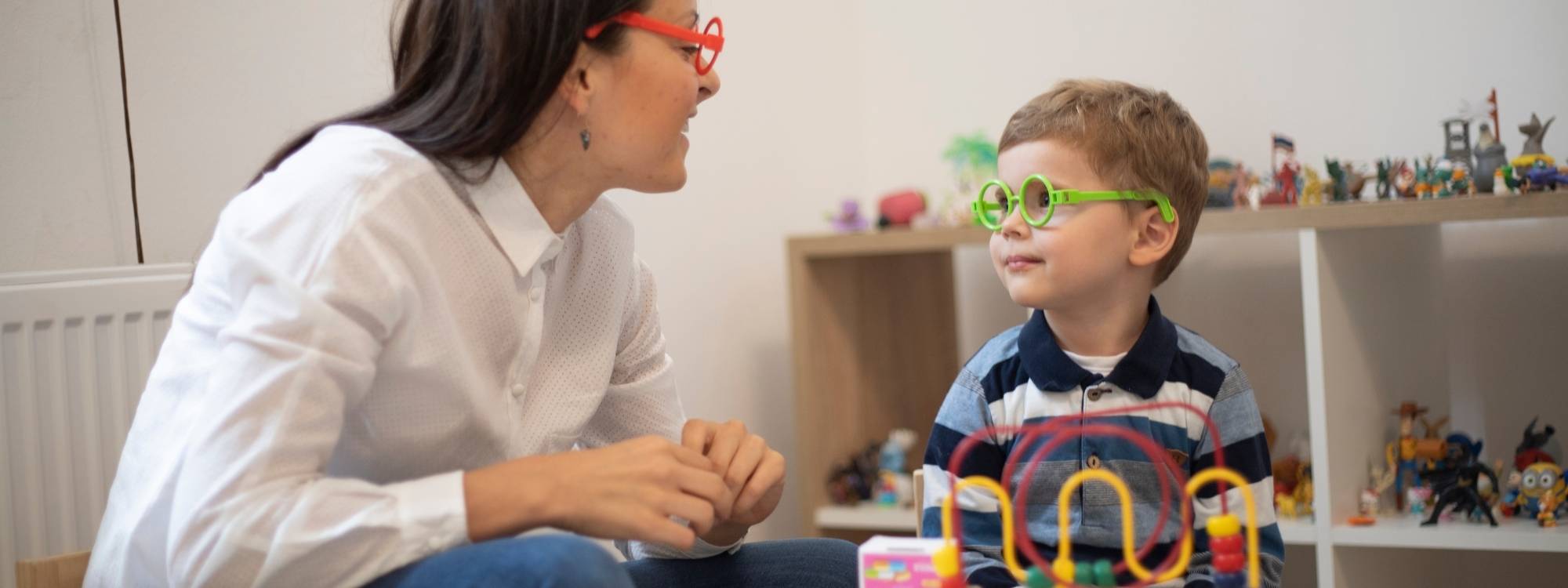Exploring the Levels of Autism: Severity and Support
Autism Spectrum Disorder (ASD) is a complex neurodevelopmental condition that affects how individuals perceive and interact with the world. While some autistic people may need minimal help navigating everyday life, others with severe autism require consistent and intensive support. To better understand and serve the diverse needs within the autism community, the Diagnostic and Statistical Manual of Mental Disorders (DSM-5) introduced a three-level classification system. These levels are based on the level of support an individual needs and help clinicians design more effective intervention plans.
This guide breaks down the three official levels of autism, how they’re diagnosed at a young age, what they mean for families, and how customized support like ABA therapy can help children thrive.
Introduction to Autism Spectrum Disorder
Autism Spectrum Disorder (ASD) is a lifelong neurodevelopmental disorder marked by persistent challenges in social communication, restricted interests, and repetitive behaviors. It encompasses a broad range of symptoms and functioning levels, which is why it’s referred to as a “spectrum.” According to the Centers for Disease Control and Prevention (CDC), about 1 in 36 children in the United States is diagnosed with ASD, highlighting the importance of early identification and personalized support strategies.
The DSM-5, developed by the American Psychiatric Association, classifies autism not by subtypes but by severity levels that reflect how much support a person needs in daily life. These levels are not meant to label or limit anyone, but rather to guide individualized care. Every autistic person is different, even those sharing the same diagnosis.
Understanding Autism Diagnosis
Diagnosing autism requires a comprehensive evaluation by trained professionals, typically including developmental pediatricians, psychologists, and speech-language pathologists. The process involves both observation and standardized tools like the Autism Diagnostic Observation Schedule (ADOS), which may include assessing reduced or abnormal responses along with parent interviews and developmental history.
Core areas evaluated include:
- Social-emotional reciprocity (e.g., difficulty initiating social interactions, limited sharing of emotions)
- Nonverbal communication skills (e.g., minimal response to social cues, poor eye contact, atypical or unsuccessful responses)
- Development of relationships (e.g., lack of interest in peers or difficulty adjusting behavior to social contexts)
- Restricted and repetitive behaviors (e.g., repetitive movements, insistence on sameness, intense interests, abnormal sensory responses)
Early diagnosis, often possible by age 18 months, allows for early intervention, crucial in helping children develop language skills, coping mechanisms, and social abilities.
Types of Autism
Before the DSM-5, autism was divided into subtypes such as Autistic Disorder, Asperger’s Syndrome, and Pervasive Developmental Disorder-Not Otherwise Specified (PDD-NOS). These labels described varying degrees of impairment in social, behavioral, and communication skills.
However, research showed that these categories lacked consistency and often overlapped. The DSM-5 replaced them with the unified diagnosis of Autism Spectrum Disorder. This change reflects the understanding that autism exists on a spectrum rather than in separate boxes.
While the medical classification has changed, many people still identify with terms like Asperger’s Syndrome or high-functioning autism. These labels may be meaningful culturally or personally, but are no longer used clinically.
Autism Spectrum Disorder (ASD)
ASD is characterized by two core domains:
- Persistent deficits in social communication and social interaction, such as challenges in maintaining conversations, understanding body language, or forming relationships.
- Restricted, repetitive patterns of behavior, including routines, rituals, and sensory sensitivities like sensitivity to light, sound, or touch.
The level of severity in these areas determines the degree of support an individual may require. These symptoms may be accompanied by significant challenges and co-occurring conditions like intellectual disability, anxiety, ADHD, or gastrointestinal issues.
Every individual with ASD is unique. Some may be verbal, others nonverbal. Some may cope well in structured environments, while others experience extreme difficulty coping with change or sensory input.
The Autism Spectrum
The term “spectrum” captures the wide variation in how autism presents. Two individuals with the same diagnosis may have entirely different support needs. One might live independently with minimal help, while another may need full-time care.
The three levels of autism, as defined by the DSM-5, are:
| Level | Description | Support Needs |
|---|---|---|
| Level 1 | Requiring Support | Difficulty with social interactions, inflexibility, may struggle in new situations without help |
| Level 2 | Requiring Substantial Support | Marked deficits in verbal and nonverbal communication, limited coping skills, and visible social impairments |
| Level 3 | Requiring Very Substantial Support | Severe impairments, minimal response to social cues, restricted interests, extreme difficulty coping |
This framework helps guide treatment planning, but doesn’t capture the full picture. A child may need Level 2 support for communication and Level 3 for behavior. Tailoring therapy to each area of need is essential.
Co-Occurring Conditions
Autistic children and adults frequently experience co-occurring conditions that compound their challenges. These may include other neurodevelopmental disorders such as intellectual disability, anxiety disorders, attention-deficit/hyperactivity disorder (ADHD), sleep disturbances, and seizures.
For example, a child with ASD and ADHD may struggle with focus and impulse control, making social interaction even more difficult. An autistic person with generalized anxiety may find even routine tasks overwhelming without extra support.
Managing these overlapping conditions requires a multidisciplinary approach that includes:
- Behavioral therapy (like ABA)
- Occupational therapy
- Speech therapy
- Medical treatment for anxiety or seizures when appropriate
By addressing all aspects of an individual’s profile, providers can build a more effective and compassionate support plan.
Autistic People and Their Needs
Autistic people thrive when their environments, supports, and expectations are tailored to their strengths and challenges, allowing them to engage with neurotypical peers effectively. While social impairments may be apparent, that doesn’t mean autistic individuals don’t want relationships; they may just express themselves differently.
Support can include:
- Structured teaching that breaks down social skills into concrete steps
- Use of sign language or communication devices for nonverbal individuals
- Sensory accommodations (e.g., noise-canceling headphones, dimmed lights)
- Positive reinforcement strategies to encourage desired behaviors
Understanding the full context of each autistic person’s life, home dynamics, educational setting, and social goals is critical to successful outcomes.
Diagnostic Criteria and Assessment
Clinicians rely on the DSM-5 for defining and diagnosing ASD. To meet the criteria, an individual must show:
- Persistent deficits in social-emotional reciprocity
- Deficits in nonverbal communicative behaviors
- Deficits in developing and maintaining relationships
- Two or more types of repetitive or restrictive behavior patterns
Assessment tools like the Autism Diagnostic Observation Schedule (ADOS) and developmental checklists help standardize diagnosis. Clinicians also collect detailed histories and observe real-life behavior patterns.
Diagnosis is not about labeling; it’s about accessing the right services. A clear understanding of an individual’s profile, including any associated mental disorders, opens doors to tailored educational support, early childhood services, and therapies that improve long-term outcomes.
Treatment Options
Treatment for autism is most effective when it’s individualized. There is no single “cure” or one-size-fits-all approach. Instead, the goal is to help autistic people build skills, reduce distress, and live full lives on their terms.
Core interventions include:
- Applied Behavior Analysis (ABA): Focuses on improving specific behaviors using positive reinforcement.
- Speech therapy: Develops verbal communication or alternative systems like PECS or AAC devices.
- Occupational therapy: Builds daily living skills and helps manage sensory sensitivities.
- Social skills training: Teaches interpersonal skills in a structured way.
- Family training: Equips caregivers to support their child’s progress at home.
These therapies are often combined based on individual needs and adjusted as children grow.
Support and Acceptance
While therapies and interventions are vital, so is societal understanding. Supportive school systems, inclusive workplaces, and empathetic communities all contribute to better outcomes for autistic people.
Acceptance means recognizing that autism is a part of human diversity. Promoting awareness, reducing stigma, and creating spaces where autistic people can thrive is essential for long-term well-being.
Inclusive practices benefit everyone, not just those with diagnoses. Building a more flexible, compassionate world starts with understanding and supporting neurodivergence.
Conclusion
Autism Spectrum Disorder is not a one-size-fits-all condition. The levels of autism, as outlined by the DSM-5, offer a helpful starting point for understanding individual support needs, but true care must go deeper. Whether a child is newly diagnosed with autism symptoms or an adult is exploring their identity, the path forward is rooted in personalized support, compassion, and informed intervention.
Recognizing the strengths and struggles of autistic individuals helps families, educators, and clinicians build plans that honor the whole person. With early diagnosis, comprehensive care, and a culture of acceptance, autistic people can lead meaningful, empowered lives.
Concerned about your child’s autism diagnosis or support needs? Champions ABA offers individualized, whole-child care for every level of autism. Whether your child requires minimal guidance or very substantial support, our team builds tailored ABA therapy plans that grow with them. Call (877) 242-1744 or visit our website to learn how we support children across the autism spectrum with compassionate, expert care.
FAQs
What are the 5 levels of autism?
The DSM-5 defines three official levels of autism based on support needs. However, some non-clinical frameworks break autism into five or more levels to describe functioning in different areas, like communication or behavior. These are not medically recognized but may be used descriptively.
What are the 7 types of autism?
Before the DSM-5, autism was classified into types such as Asperger’s Syndrome, Childhood Disintegrative Disorder, Rett Syndrome, and Pervasive Developmental Disorder. These were consolidated into one diagnosis, Autism Spectrum Disorder, to reflect the variability in how autism presents.
What are levels 1, 2, and 3 in autism?
Level 1 indicates a need for some support, Level 2 requires substantial support, and the very substantial support level of Level 3 calls for very substantial support. These levels help clinicians describe the amount of help a person may need in areas like social interaction and behavior.
How do I tell if I’m autistic?
Signs of autism in adults may include difficulty with social cues, sensory overload, repetitive behaviors, or a preference for routines. If you suspect you might be autistic, consider speaking with a psychologist or developmental specialist for a formal evaluation. Self-assessment tools can also be a helpful first step



